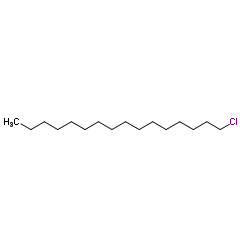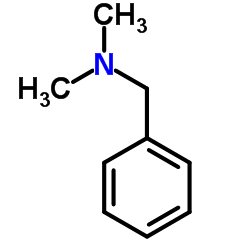Cetalkonium chloride

Cetalkonium chloride structure
|
Common Name | Cetalkonium chloride | ||
|---|---|---|---|---|
| CAS Number | 122-18-9 | Molecular Weight | 396.092 | |
| Density | N/A | Boiling Point | N/A | |
| Molecular Formula | C25H46ClN | Melting Point | 55-65 °C(lit.) | |
| MSDS | Chinese USA | Flash Point | N/A | |
| Symbol |



GHS05, GHS07, GHS09 |
Signal Word | Danger | |
Use of Cetalkonium chlorideCetalkonium chloride is an ammonium antiseptic agent used in many topical drugs for infections of mouth, throat and eye. Cetalkonium chloride acts as anti-inflammatory amphiphilic agent[1]. |
| Name | Benzyldimethylhexadecylammonium chloride |
|---|---|
| Synonym | More Synonyms |
| Description | Cetalkonium chloride is an ammonium antiseptic agent used in many topical drugs for infections of mouth, throat and eye. Cetalkonium chloride acts as anti-inflammatory amphiphilic agent[1]. |
|---|---|
| Related Catalog | |
| References |
| Melting Point | 55-65 °C(lit.) |
|---|---|
| Molecular Formula | C25H46ClN |
| Molecular Weight | 396.092 |
| Exact Mass | 395.331879 |
| LogP | 4.74830 |
| Water Solubility | MODERATELY SOLUBLE |
CHEMICAL IDENTIFICATION
HEALTH HAZARD DATAACUTE TOXICITY DATA
|
| Symbol |



GHS05, GHS07, GHS09 |
|---|---|
| Signal Word | Danger |
| Hazard Statements | H302 + H312-H314-H400 |
| Precautionary Statements | P273-P280-P305 + P351 + P338-P310 |
| Personal Protective Equipment | Eyeshields;Faceshields;full-face particle respirator type N100 (US);Gloves;respirator cartridge type N100 (US);type P1 (EN143) respirator filter;type P3 (EN 143) respirator cartridges |
| Hazard Codes | C:Corrosive;N:Dangerousfortheenvironment; |
| Risk Phrases | R21/22;R34;R50 |
| Safety Phrases | S61-S45-S36/37/39-S26 |
| RIDADR | UN 3077 9/PG 3 |
| WGK Germany | 3 |
| RTECS | BO6822450 |
| Hazard Class | 9.0 |
| HS Code | 2923900090 |
|
~% 
Cetalkonium chloride CAS#:122-18-9 |
| Literature: Pharmaceutical Chemistry Journal, , vol. 18, # 11 p. 784 - 787 Khimiko-Farmatsevticheskii Zhurnal, , vol. 18, # 11 p. 1344 - 1348 |
|
~% 
Cetalkonium chloride CAS#:122-18-9 |
| Literature: Journal of the American Chemical Society, , vol. 105, # 6 p. 1567 - 1571 |
|
~% 
Cetalkonium chloride CAS#:122-18-9 |
| Literature: Yakugaku Zasshi, , vol. 63, p. 589 Chem.Abstr., , p. 5100 US2075958 , ; |
|
~% 
Cetalkonium chloride CAS#:122-18-9 |
| Literature: Pharmaceutical Chemistry Journal, , vol. 18, # 11 p. 784 - 787 Khimiko-Farmatsevticheskii Zhurnal, , vol. 18, # 11 p. 1344 - 1348 |
|
~% 
Cetalkonium chloride CAS#:122-18-9 |
| Literature: Chemische Berichte, , vol. 73, p. 1007 |
| HS Code | 2923900090 |
|---|---|
| Summary | 2923900090 other quaternary ammonium salts and hydroxides。Supervision conditions:None。VAT:17.0%。Tax rebate rate:9.0%。MFN tariff:6.5%。General tariff:30.0% |
|
Effect of the cationic surfactant moiety on the structure of water entrapped in two catanionic reverse micelles created from ionic liquid-like surfactants.
ChemPhysChem 15(14) , 3097-109, (2014) The behavior of water entrapped in reverse micelles (RMs) formed by two catanionic ionic liquid-like surfactants, benzyl-n-hexadecyldimethylammonium 1,4-bis-2-ethylhexylsulfosuccinate (AOT-BHD) and ce... |
|
|
Characterization of antibiotic and disinfectant susceptibility profiles among Pseudomonas aeruginosa veterinary isolates recovered during 1994-2003.
J. Appl. Microbiol. 118(2) , 326-42, (2015) To evaluate susceptibility of Pseudomonas aeruginosa veterinary isolates to antibiotics and disinfectants.Pseudomonas aeruginosa isolates collected from dogs (n = 155) and other animals (n = 20) from ... |
|
|
Determination of quaternary ammonium compounds in oranges and cucumbers using QuEChERS extraction and ultra-performance liquid chromatography/tandem mass spectrometry.
J. AOAC Int. 97(4) , 1021-6, (2014) A simple and fast method has been developed for determining relevant quaternary ammonium compounds in cucumber and orange samples. The target compounds were benzoalkonium chloride (BAC-10, BAC-12, BAC... |
| N-hexadecyl-N,N-dimethyl-N-benzylammonium chloride |
| dimethylbenzylhexadecylammonium chloride |
| Cetyldimethylbenzylammonium |
| hexadecyldimethylbenzylammonium chloride |
| EINECS 204-526-3 |
| Acquat CDAC |
| acinol |
| Cetol |
| Cetylbenzyldimethylammonium chloride |
| benzyl-dimethyl-cetylammonium chloride |
| MFCD00011625 |
| benzyl-dimethyl-hexadecyl-ammonium chloride |
| dmcbac |
| CKC |
| benzyl-n-hexadecyldimethyl ammonium chloride |
| Cetalkonium chloride |
| N-Benzyl-N,N-dimethylhexadecan-1-aminium chloride |
| 16-BAC,Benzylhexadecyldimet |
| cdbac |
| Cetyldimethylbenzylammonium chloride |
| Ammonyx T |
| banicol |
| Benzylhexadecyldimethylammonium Chloride Hydrate |
| Benzylcetyldimethylammonium Chloride Hydrate |
| N-Benzyl-N,N-dimethyl-1-hexadecanaminium chloride |
| win357 |
| Acetoquat CDAC |
| spilan |
| Benzyldimethyl-n-hexadecylammonium chloride |
| benzylhexadecyldimethylammonium chloride |
| Benzenemethanaminium, N-hexadecyl-N,N-dimethyl-, chloride (1:1) |
| Zettyn |
| cetylon |
| bonjela |
| Ammonyx G |
| HDBAC |
| Benzyldimethylhexadecylammonium Chloride Hydrate |








